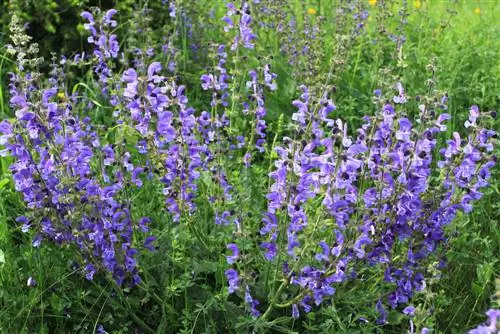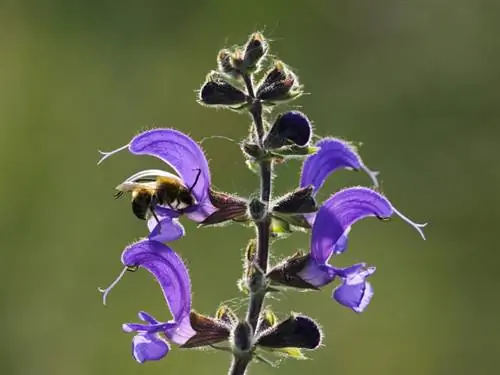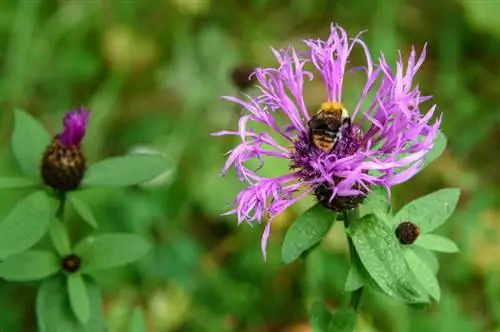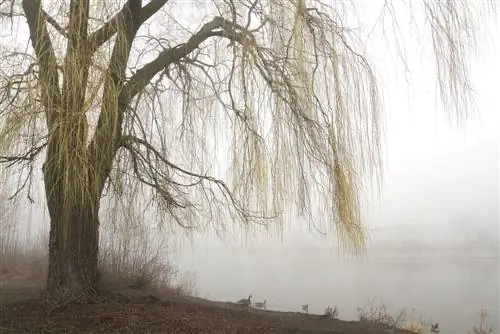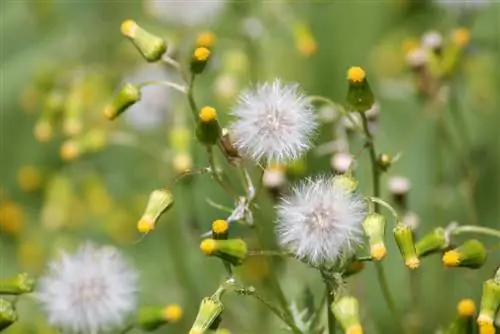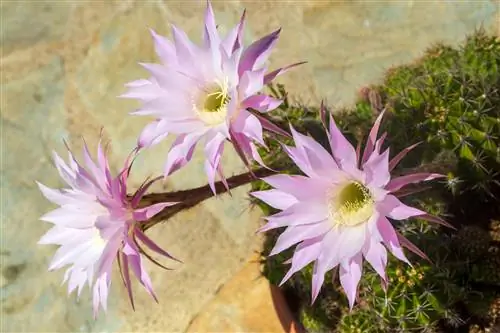- Author admin [email protected].
- Public 2023-12-16 16:46.
- Last modified 2025-01-23 11:22.
Read interesting information about leaves, flowers and pollination (keyword lever mechanism) in the commented meadow sage profile here. You can find out how to properly plant and care for summer sage here.

What is meadow sage and what does it look like?
Meadow sage (Salvia pratensis) is a perennial with elongated, fragrant leaves and lip-shaped, hermaphrodite flowers. The flowering period extends from May to August, with pollination taking place via a lever mechanism. Meadow sage is suitable as an ornamental perennial, bee pasture and useful plant.
Profile
- Scientific name: Salvia pratensis
- Family: Mint family (Lamiaceae)
- Synonym: wild sage, summer sage
- Occurrence: Europe, Caucasus, North America
- Growth type: Perennial
- Growth height: 40 cm to 60 cm
- Leaves: elongated, fragrant
- Flower: lip-shaped, hermaphrodite
- Flowering period: May to August
- Pollination: lever mechanism
- Toxicity: not poisonous
- Use: ornamental perennial, bee willow, useful plant
leaves
Meadow sage thrives as a perennial semi-rosette plant. Most of the leaves gather near the ground to form a densely packed rosette. There are only a few leaves on the tightly upright, square stems. The following features are characteristic of a meadow sage leaf:
- Leaf shape: broad-lanceolate, stalked or sessile, pointed, toothed leaf edge
- Texture: wrinkled, finely hairy
- Leaf color: gray-green to dark green
- Arrangement: opposite pairs
- Consumption quality: edible
Essential oils in the leaves create an aromatic scent and invite you to taste them. Although the aroma content is significantly lower than that of real sage (Salvia officinalis), meadow sage leaves are suitable as a mild spice and healing tea.
Bloom
The high appreciation of meadow sage is primarily based on its picturesque flowers. The following overview summarizes all the important flower properties:
- Shape: Labiate with lower lip and helmet-shaped upper lip as a roof for 2 stamens and 1 style
- Special feature: dust bag spacers converted into a plate with lever function and movable barrier
- Flower color: light to medium blue (varieties bloom pink, white or violet to violet-blue)
- Flower size: 1.0 to 1.5 cm
- Arrangement: terminal, panicle to spike-shaped in loose whorls
- Pollinators: long-pronged insects, mainly bumblebees
- Fruits: Split fruits with four single-seeded, black claws
The labiate of wild sage contains abundant nectar as a reward for pollinators. In order for the insects to snack on the sweet nectar, a great effort is required. Read about pollination in the following section.
Pollination
During the flowering period, meadow sage has a special feature that amazes hobby gardeners both young and old. For successful pollination, Mother Nature has equipped all types of sage with an ingenious lever mechanism, also known as the sage mechanism or barrier mechanism. The operating principle is as simple as it is effective:
- Bumblebee lands on the lower lip as a perch.
- Bumblebee presses its long trunk onto the plate that blocks access to the nectar in the flower tube.
- Strong pressure from the trunk triggers the lever mechanism.
- Plate opens, anther arm hits the hairy bumblebee body and transfers a portion of pollen.
- Bumblebee feasts on the nectar and flies to the next meadow sage blossom with pollen in its luggage.
Look at the fascinating barrier mechanism on meadow sage in the following video:
Video: Lever mechanism on meadow sage
Occurrences
The wild sage is a perennial cradle in the Mediterranean region. Meadow sage is now widespread throughout Europe, adorning roadsides, wildflower meadows and alpine meadows up to 1,600 meters above sea level. The northern limit is in central Sweden, where isolated occurrences can be found in protected locations. Summer sage has also been found across the Atlantic since the wild plant was introduced to North America.
Usage
Meadow sage combines natural charm, aromatic scent and beneficial active ingredients with tough winter hardiness. This allows hobby gardeners who are close to nature to come up with ideas for a variety of possible uses. Be inspired by the options in the following table:
| Usage | Idea |
|---|---|
| Natural Garden | insect-friendly path edging |
| Cottage Garden | fragrant bed border |
| Herb garden | Medicinal plant, culinary herb |
| Mediterranean Garden | planted as tuff for color accents |
| Bee Pasture | Flower strips in the front garden |
| potted plant | on balcony, terrace, roof garden |
| Cut flower | fresh as vase decoration |
| Dried Flower | dried as a bouquet or arrangement |
Planting meadow sage
Like all wild plants, you can plant meadow sage almost all year round. The best time for sowing directly into the bed is in April. The time window for growing on the bright windowsill or sowing in the cold frame opens at the end of February/beginning of March. In spring and autumn you can buy ready-grown young plants commercially. Plant meadow sage 35 cm apart. For extensive greenery, plant 8 to 10 specimens in the ground per square meter.
Location
Meadow sage shows its most beautiful side under the following conditions:
- Full sun to sunny location, prefers to be warm and sheltered from the wind.
- Calcareous, moderately nutrient-rich soil.
- Sandy-dry to fresh garden soil without the risk of waterlogging
In the pot, summer sage decorates the south-facing balcony, the sunny terrace and the sun-drenched roof garden. A suitable substrate is a mixture of peat-free pot plant soil (€19.00 on Amazon), coconut humm, sand and lava granules over a drainage made of grit or expanded clay.
Excursus
Combine meadow sage creatively
With fragrant meadow sage and colorful wild plants, you can conjure up a blooming summer fairy tale in the garden. Combine Salvia pratensis with white meadow yarrow (Achillea millefolium), yellow girl's eye (Coreopsis), red-flowering corn poppy (Papaver rhoeas) and the silvery-blue man's litter flowers (Eryngium zabelii). Stylish contrasts arise in the company of silver- and gray-leafed sun worshipers, such as Lavandula 'Richard Grey'.
Care for meadow sage
Meadow sage is very easy to care for. Hobby gardeners with limited free time can leave the wild plants in the natural garden to their own devices. In the pot, summer sage is grateful for a little gardening attention. A pruning allows the fragrant natural beauty to bloom decoratively. Don't miss these care tips for meadow sage in top shape:
Pouring
Short-term drought leaves meadow sage without a trace. Waterlogging causes root rot after just a short time and ends all hopes of perennial growth. Water meadow sage with regular tap water when the soil feels dry. In the pot, wild sage requires daily watering in the heat of summer. Bedding plants are usually content with an occasional rain shower.
Fertilize
Organic starter fertilization in spring stimulates growth and stimulates flowering. In order not to damage the leaf rosettes close to the ground, ideally administer nettle manure diluted with water or an organic liquid fertilizer. Alternatively, sprinkle mature, sifted compost onto the root disc and work the fertilizer into the soil by hand.
Cutting
Meadow sage is one of the remontant wild plants. Pruning after the first bloom clears the way for the autumn blooms. Cut the perennial back to the leaves. This is usually about half of the plant height. Then give a liquid flower fertilizer.
Propagate
The easiest way to propagate the pure species Salvia pratensis is by sowing seeds. Harvest the ripe split fruits in autumn. These break down into four black, lonely hermitages. Keep the seeds dark and dry until next spring for direct sowing in the bed or cultivation on the windowsill.
Two vegetative propagation methods guarantee that the decorative properties of meadow sage varieties are retained. If you would like to double the existing number of wild plants, we recommend dividing them in spring or autumn. To grow numerous young summer sages, cut 6 cm to 8 cm long, herbaceous cuttings in early summer and let them root in a pot or partially shaded bed.
Popular varieties
Meadow sage brings color to the garden if you combine the original species with these beautiful varieties:
- Pink Delight: graceful meadow sage variety with pink flowers and delicately hairy leaves that exude an aromatic scent.
- Swan Lake: compact summer sage with bright white flowers and beautiful rebloom in autumn.
- Rhapsody in Blue: impresses with bright blue flower spikes and a tightly upright silhouette up to 60 cm tall.
- Rose Rhapsody: pink-flowering premium variety, richly branched, aromatic and reliably remontant.
- Madeline: rare two-tone meadow sage variety with violet-blue-white labial flowers from May.
- Eveline: impresses with large rose quartz-colored flowers and a tightly upright silhouette up to 55 cm tall.
FAQ
Are meadow sage flowers edible?
Yes, the flowers of meadow sage are edible. Use young flowers as an aromatic decoration for cold dishes, such as crispy garden salad or spicy herb quark. The taste of summer sage flowers is significantly milder than that of common sage (Salvia officinalis).
My meadow sage does not bloom after being cut back. What did I do wrong?
So that meadow sage can be replanted reliably, pruning is limited to half the plant height. The leaves close to the ground must remain standing so that the perennial can sprout again. Furthermore, a commercially available liquid fertilizer gives your summer sage the energy it needs for autumnal rebloom.
Does meadow sage as a tea have the same effect as medicinal sage?
Meadow sage is known, among other things, as a medicinal plant for various ailments, such as colds, coughs, night sweats, diarrhea or all kinds of inflammation. In contrast to its big brother, real sage (Salvia officinalis), meadow sage contains significantly fewer essential oils and other healing ingredients. If in doubt, medicinal sage is preferable to a tea made from meadow sage leaves.
Where does meadow sage grow?
Meadow sage adorns roadsides and other sunny, dry, moderately nutrient-rich locations in Europe, Asia Minor and the Caucasus. Since wild sage was introduced to North America, the wild plant has also become naturalized beyond the Atlantic. In the Alps, the picturesque wild perennial climbs to a height of 1,600 meters.
Is meadow sage poisonous?
No, meadow sage is not poisonous. Wild sage (Salvia pratensis) contains a similar combination of active ingredients as real sage (Salvia officinalis), but in a significantly lower concentration. For this reason, summer sage is of secondary importance as a spice and medicinal plant. The wild plant is very popular as a harmless ornamental perennial for the family garden or a swarming pasture for bees in the natural garden.
Is there a risk of confusing meadow sage with other wild plants?
Meadow sage is one of the most common flowers you can admire in summer meadows and along roadsides. With its light to medium blue labial flowers and a height of 60 cm, wild sage is easy to recognize. There is no risk of confusion with other wild plants. A sniff test clears up any remaining doubts. If you rub a meadow sage leaf between your fingers, a pleasant, aromatic scent will spread.

